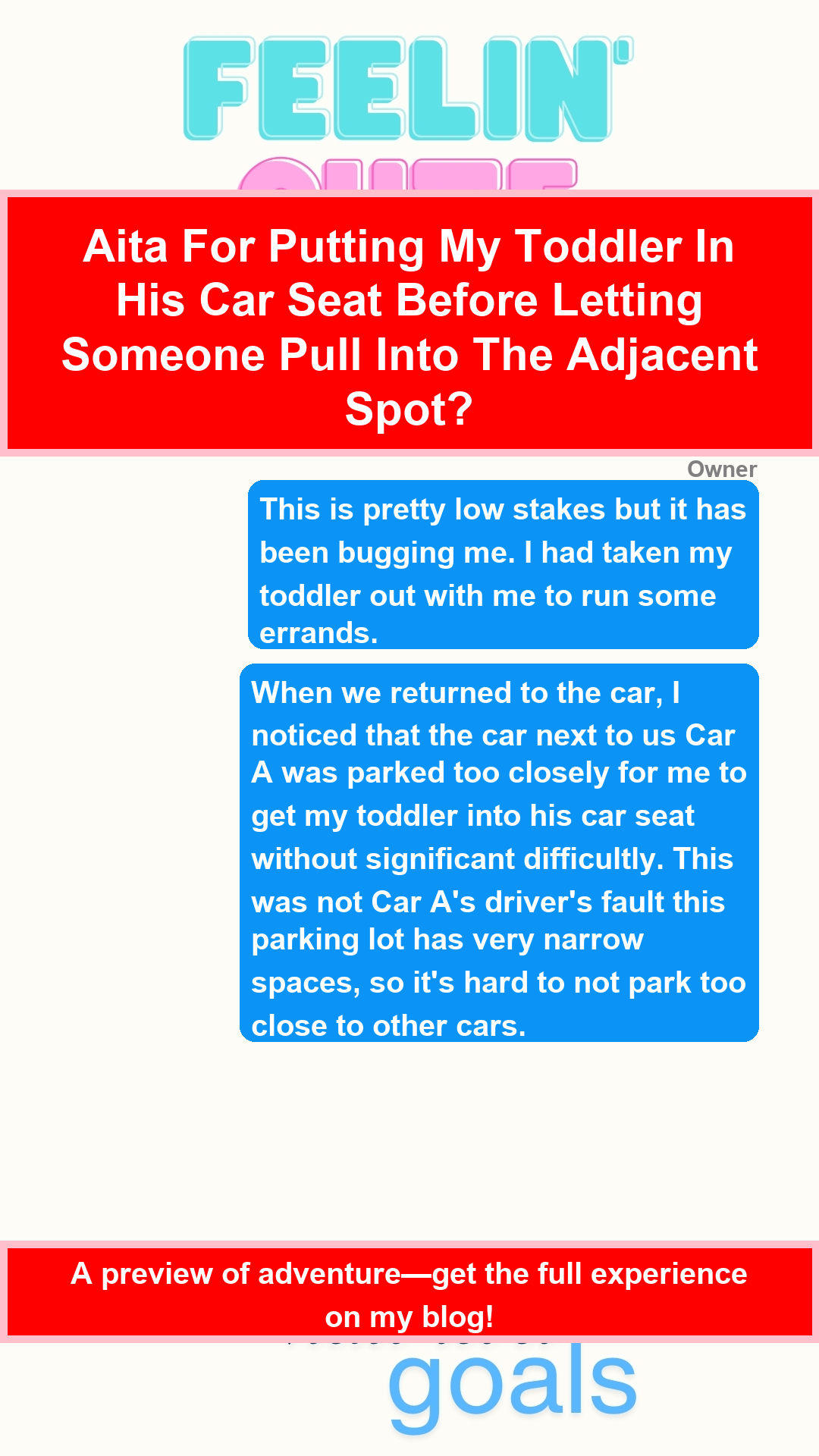AITA for putting my toddler in his car seat before letting someone pull into the adjacent spot?
 Image credit: Pixabay (This is example image – Not the actual photo)
Image credit: Pixabay (This is example image – Not the actual photo)
Parking Lot Dilemma: Who’s in the Right?
In a seemingly trivial parking lot encounter, a parent faces a moral quandary when waiting for a spot to open up while trying to load their toddler into the car. After patiently waiting for Car A to leave, they inadvertently block Car B from swooping in, leading to an unexpected confrontation. This relatable scenario raises questions about etiquette, patience, and the challenges of parenting in tight spaces. How do we balance our needs with the expectations of others in everyday situations?
Family Drama Over Parking Spot: AITA?
This situation revolves around a minor conflict that escalated due to a misunderstanding in a crowded parking lot. Here’s a breakdown of the events:
- Setting: A busy parking lot with narrow spaces.
- Characters:
- The narrator, who is a parent with a toddler.
- Driver of Car A, who was parked too closely.
- Driver of Car B, who attempted to take Car A’s spot.
The narrator had taken their toddler out for errands and faced a challenge when returning to their car:
- The narrator noticed that Car A was parked too closely, making it difficult to safely place their toddler in the car seat.
- Understanding the situation, the narrator decided to wait for Car A to leave rather than attempt to squeeze into the tight space.
- After approximately five minutes, Car A finally pulled out of the spot.
As Car A exited, another vehicle, Car B, arrived and signaled their intention to take the now-vacant spot:
- Before Car B could pull in, the narrator opened their car door to load their toddler into the car seat.
- Car B’s driver reacted negatively, honking and gesturing angrily before driving away in search of another parking space.
The narrator is left questioning their actions:
- They acknowledge that waiting for Car A was necessary due to the tight parking situation.
- However, they wonder if they should have prioritized Car B’s attempt to park, despite the potential for the same space issue.
This incident highlights the tension that can arise in everyday situations, particularly in crowded areas. The narrator seeks clarity on whether they were in the wrong for prioritizing their child’s safety over the convenience of another driver.
In summary, this story illustrates a common scenario where family drama and parking conflicts intersect, raising questions about etiquette and conflict resolution in public spaces.
This is Original story from Reddit
 Image credit: Pixabay (This is example image – Not the actual photo)
Image credit: Pixabay (This is example image – Not the actual photo)
Story
This is pretty low stakes, but it has been bugging me.
I had taken my toddler out with me to run some errands. When we returned to the car, I noticed that the car next to us, Car A, was parked too closely for me to get my toddler into his car seat without significant difficulty.
This was not Car A’s driver’s fault; this parking lot has very narrow spaces, so it’s hard to not park too close to other cars. Fortunately, Car A seemed to be leaving, so I decided to wait until they pulled out of the spot before trying to load my toddler into the car.
It ended up being about 5 minutes before Car A left. At some point, more than halfway through our wait, Car B pulled up and put their blinker on, indicating that they were going to take Car A’s spot.
Car A pulled out, and before Car B pulled in, I walked around to the side of the car and opened the door to put my toddler in his car seat. Car B’s driver got mad, honked, flipped us off, and drove away to presumably find another spot.
AITA for not letting Car B pull into the spot first? I get that it’s annoying having to wait, but I would’ve ended up in the same dilemma of not having enough space had I let Car B in.
View the Original Reddit Post Here
Summary of Reddit Comments
The top Reddit comments indicate a unanimous agreement that the original poster (OP) is not at fault (NTA) for prioritizing their child’s safety while waiting to put them in the car. Many users emphasize that Driver B’s impatience was unwarranted, as OP was simply ensuring their child’s well-being before moving. The comments reflect a broader understanding that safety should take precedence over minor inconveniences in parking situations.
Verdict: NTA
Expert Advice for Resolving the Parking Conflict
Conflicts in crowded public spaces, such as parking lots, can often escalate due to misunderstandings and differing priorities. Here are some practical steps for both the narrator (OP) and Driver B to consider in resolving this situation and preventing future conflicts:
For the Narrator (OP)
- Prioritize Safety: Continue to prioritize your child’s safety when navigating tight spaces. Always ensure that your toddler is secure before moving your vehicle.
- Communicate Clearly: If you notice another driver waiting for a spot, a simple wave or nod can signal that you are aware of their presence and are waiting for the space to be clear.
- Be Patient: Understand that parking situations can be stressful for everyone involved. Remaining calm and composed can help diffuse tension.
For Driver B
- Practice Patience: Recognize that parking lots can be chaotic, and sometimes waiting a few extra moments is necessary for safety.
- Assess the Situation: Before reacting, take a moment to observe what is happening. If another driver is loading a child, it’s important to allow them the time they need.
- Communicate Respectfully: If you feel frustrated, consider expressing your feelings in a calm manner rather than resorting to honking or gestures. A polite wave or a simple smile can go a long way.
General Tips for All Drivers
- Be Mindful of Others: Everyone is navigating their own challenges in busy environments. A little empathy can help ease tensions.
- Consider Alternative Parking: If a parking lot is particularly crowded, it may be worth looking for alternative spaces, even if it means walking a bit further.
- Practice Conflict Resolution: If conflicts arise, try to approach them with a mindset of understanding rather than confrontation. Open dialogue can often lead to resolution.
By following these steps, both parties can contribute to a more harmonious parking experience and reduce the likelihood of similar conflicts in the future. Remember, a little patience and understanding can go a long way in everyday situations.
Join the Discussion
 Image credit: Pixabay (This is example image – Not the actual photo)
Image credit: Pixabay (This is example image – Not the actual photo)
What do you think? Would you have handled this differently?
Share your thoughts below! Vote: Do you agree with Reddit’s verdict?






